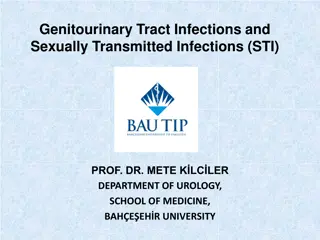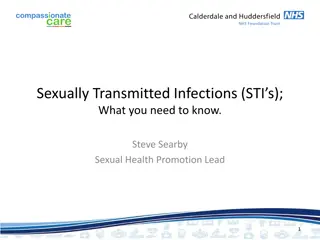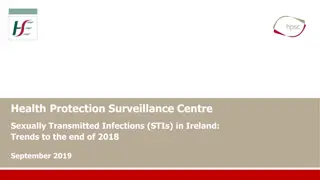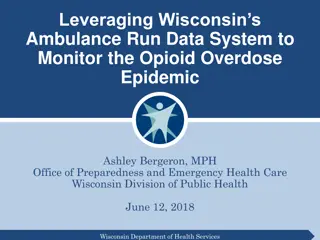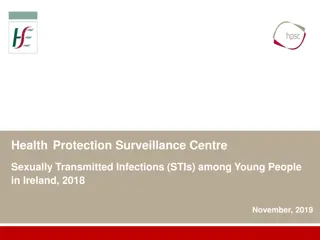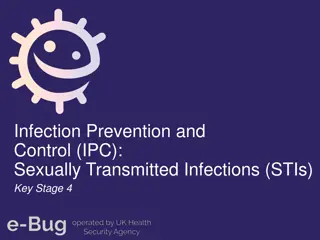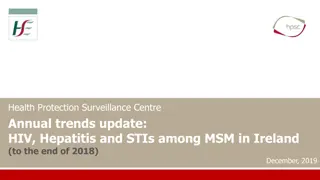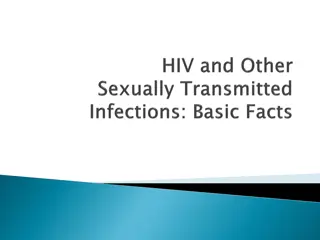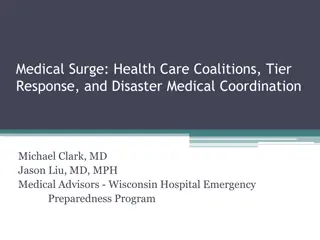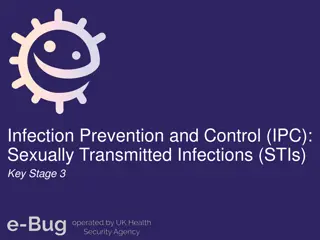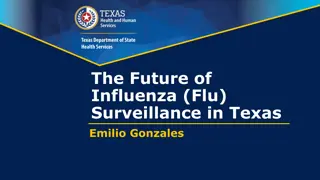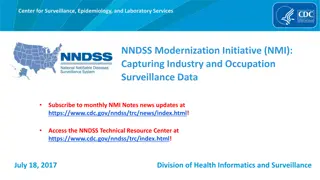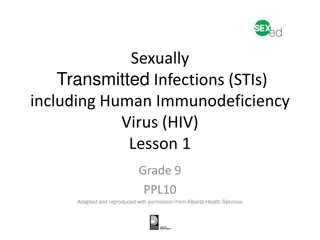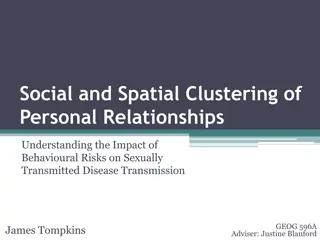2022 Wisconsin STIs Surveillance Data
Analyzing reported cases of Sexually Transmitted Infections (STIs) in Wisconsin for the year 2022, as documented by the Division of Public Health's STI Unit. The data provides valuable insights into the epidemiology and trends of STIs in the region, aiding in public health decision-making and interventions.
Download Presentation

Please find below an Image/Link to download the presentation.
The content on the website is provided AS IS for your information and personal use only. It may not be sold, licensed, or shared on other websites without obtaining consent from the author. Download presentation by click this link. If you encounter any issues during the download, it is possible that the publisher has removed the file from their server.
E N D
Presentation Transcript
Wisconsin Sexually Transmitted Infections (STIs) Surveillance Data Reported Cases in 2022 Division of Public Health Bureau of Communicable Diseases STI Unit P-00415 (07/2023)
Introduction Reportable Sexually Transmitted Infections (STIs) in Wisconsin: Chlamydia trachomatis (Chlamydia) - Includes disease classifications such as urethritis, cervicitis and conjunctivitis. Neisseria gonorrhoeae (Gonorrhea) - Includes disease classifications such as urethritis, cervicitis, and resistant strains. Resistant or reduced susceptibility to antibiotic treatment are confirmed by antibiotic susceptibility testing (AST). Treponema pallidum (Syphilis ) - Wisconsin data includes all stages and CDC data includes primary and secondary stages of syphilis. To protect and promote the health and safety of the people of Wisconsin. 2
Introduction Sexually transmitted infections (STIs) surveillance data are collected systematically through WEDSS* for the purpose of monitoring the frequency and distribution of STIs in the Wisconsin population. This analysis examines trends in reportable STIs in Wisconsin to identify problem areas and allocate resources for effective STI interventions. Out of state, cases from correctional facilities, and unknown states are not included. Rates are calculated based on 2020 population data available in Wisconsin Interactive Statistics on Health (WISH) population module. *WEDSS is a secure, web-based system designed to facilitate reporting, investigation, and surveillance of communicable diseases in Wisconsin. It is designed for public health staff, infection control practitioners, clinical laboratories, clinics, and other disease reporters. To protect and promote the health and safety of the people of Wisconsin. 3
STIs surveillance data should be interpreted with caution STI data may be underreported, unevenly reported, and incomplete. Elements that impact the completeness and accuracy of STI data include: Practices and capacity of STI screening by health care providers. Health care providers compliance with case reporting. Completeness and promptness of case reporting. COVID-19 may have influenced the number of cases diagnosed and reported in 2020 and 2021. To protect and promote the health and safety of the people of Wisconsin. 4
How Does Wisconsin Compare with Neighboring States?
Chlamydia cases per 100,000 people in Wisconsin and neighboring states: 2021 542 481 479 456 448 392 U.S. total Illinois Iowa Wisconsin Michigan Minnesota 6 To protect and promote the health and safety of the people of Wisconsin.
Gonorrhea cases per 100,000 people in Wisconsin and neighboring states: 2021 245 234 219 207 183 178 U.S. total Illinois Michigan Iowa Minnesota Wisconsin 7 To protect and promote the health and safety of the people of Wisconsin.
Primary and secondary syphilis cases per 100,000 in Wisconsin and neighboring states: 2021 12 11 7 7 4 3 U.S. total Illinois Minnesota Michigan Iowa Wisconsin 8 To protect and promote the health and safety of the people of Wisconsin.
Reported Cases of Sexually Transmitted Infections (STIs) 2022
The number of reported STI cases have increased by 23% in Wisconsin from 2015 to 2022. STI trend in Wisconsin 2022 45,000 37,957 36,299 40,000 35,000 29,459 30,000 25,000 20,000 15,000 10,000 5,000 0 2015 2016 2017 2018 2019 2020 2021 2022 To protect and promote the health and safety of the people of Wisconsin. 10
STI rates per 100,000 population of reported STI cases, Wisconsin - 2022 2022 Syphilis 33 Gonorrhea 150 Chlamydia 440 0 100 200 300 400 500 To protect and promote the health and safety of the people of Wisconsin. 11
Syphilis (all stages) - rates of reported cases in Wisconsin 2013 2022 Rateof reported Syphilis cases increased 556% since 2013 Syphilis Trend 35 33 30 25 20 14 15 9 10 7 5 5 0 2014 2016 2018 2020 2022 Rate per 100,000 population To protect and promote the health and safety of the people of Wisconsin. 12
Chlamydia - rate of reported cases in Wisconsin 2013 2022 490 470 449 440 406 2014 2016 2018 2020 2022 Rate per 100,000 population 13 To protect and promote the health and safety of the people of Wisconsin.
Gonorrhea - rate of reported cases in Wisconsin 2013 2022 Gonorrhea rate decreased 17% in 2022 from 2021 175 150 139 115 72 2014 2016 2018 2020 2022 Rate per 100,000 population 14 To protect and promote the health and safety of the people of Wisconsin.
Primary and secondary syphilisrates of reported cases by state, United States and territories, 2012 and 2021 15 To protect and promote the health and safety of the people of Wisconsin.
Syphilis (All stages) rates of reported cases by county, Wisconsin, 2012 and 2021 2022 2012 16 To protect and promote the health and safety of the people of Wisconsin.
Syphilis (All stages) rate increased by 18% from 2021-2022 in Wisconsin. Trends of Syphilis Cases and) Wisconsin 2014 2022 Chart Title 33 2000 35 1800 28 30 1600 25 1400 Syphilis case Syphilis rate 1200 20 1000 14 15 800 10 10 9 600 7 10 5 5 400 5 1915 200 279 270 427 563 511 585 810 1608 0 0 2014 2015 2016 2017 2018 2019 2020 2021 2022 Axis Title Rates (per 100,000 population 17 To protect and promote the health and safety of the people of Wisconsin.
People aged 3039 have the highest primary and secondary syphilis rate reported - 2022. Number of primary and secondary syphilis rates per 100,000 people by age Wisconsin: 2018 2022 Primary and Secondary Reported Syphilis in 2022 32 35 Age 20-29 28 29 18 30 Age 30-39 28 18 25 Age 40-49 20 15 9 8 7 9 6 10 Age 15-19 5 2 0 2018 2019 2020 2021 2022 To protect and promote the health and safety of the people of Wisconsin. 18
Men have a higher rate of Syphilis, the rate remained same for women from 2021 2022. Number of primary and secondary syphilis rates per 100,000 people by sex at birth, Wisconsin: 2018 2022 2.7 times higher than women Chart Title 19 18 20 Male 18 16 14 12 10 7 7 Female 8 5 6 4 1 2 0 2018 2019 2020 2021 2022 To protect and promote the health and safety of the people of Wisconsin. 19
Black people have the highest primary and secondary syphilis rate in Wisconsin - 2022. Number of primary and secondary syphilis rates per 100,000 people by race and ethnicity, Wisconsin: 2018 2022 Rate of reported syphilis case by race 2018-2022 Rate of primary and secondary syphilis in Black is 25 times the rate among White and 13 times the Asian and 4 times the Native American. 120 104 Black 101 100 80 60 Native American Asian White 14 5 26 40 23 8 2 0 20 4 4 4 2021 0 2018 2019 2020 2022 To protect and promote the health and safety of the people of Wisconsin. 20
The Southeastern Region has the highest syphilis (All stages)rate in Wisconsin. Number of syphilis diagnoses per 100,000 population by region of residence, Wisconsin: 2022 66 1600 70 1400 60 1200 50 1000 40 800 30 17 600 14 12 10 20 400 176 48 1353 212 94 10 200 0 0 Syphilis Cases by Region Syphilis Rate by Region Note: Cases from corrections and unknown county are not included. 21 To protect and promote the health and safety of the people of Wisconsin.
Congenital Syphilis To protect and promote the health and safety of the people of Wisconsin. 22
Trend of reported congenital Syphilis cases in Wisconsin 2013 - 2022 Congenital syphilis cases are in increasing trend in Wisconsin, and so is Nationally Trend of Reported Congenital Syphilis Cases in Wisconsin 2022 29 480% increase from 2020 to 2022 16 5 3 2 1 0 0 0 0 2013 2014 2015 2016 2017 2018 2019 2020 2021 2022 To protect and promote the health and safety of the people of Wisconsin.
Distribution of congenital syphilis cases by county in Wisconsin 2022 (n=29) Milwaukee county accounts for 82% of reported congenital Syphilis cases in Wisconsin. Count of cases To protect and promote the health and safety of the people of Wisconsin. 24
Distribution of congenital Syphilis cases in Milwaukee County by zip code - 2022 25 To protect and promote the health and safety of the people of Wisconsin.
Chlamydia Trends: Nationally and in Wisconsin
Chlamydiarates of reported cases by state, United States and territories, 2012 and 2021 27 To protect and promote the health and safety of the people of Wisconsin.
Chlamydia cases per 100,000 persons by county, Wisconsin, 2012 and 2022 2022 2012 28 To protect and promote the health and safety of the people of Wisconsin.
People aged 3039 is the only age group that have increased chlamydia rates in Wisconsin. Number of chlamydia diagnoses per 100,000 people by age at diagnosis, Wisconsin, 2018 2022 2,642 Age 20 24 2,407 1,866 1,357 Age 15 19 Age 25 29 Age 30 39 1,754 1,165 324 260 498 129 Age 40 49 2018 2019 2020 2021 2022 To protect and promote the health and safety of the people of Wisconsin. 29
While cis-women have a higher rate of chlamydia in Wisconsin, the rate decreased in both cis-men and cis-women from 2021 2022. Number of chlamydia diagnoses per 100,000 people by sex at birth Wisconsin, 2018 2022 635 Female 577 (-9.1%) 316 299 Male (-5.4%) 2018 2019 2020 2021 2022 To protect and promote the health and safety of the people of Wisconsin. 30
While Black people have a higher rate of Chlamydia in Wisconsin, the rate increased most in Native Americans from 2021 to 2022. Number of Chlamydia diagnoses per 100,000 people by race Wisconsin, 2018-2022 Chart Title 2413 Black 2327 723 (13%) 239 Native American 642 234 Asian White 221 2021 205 2018 2019 2020 2022 To protect and promote the health and safety of the people of Wisconsin. 31
While the Chlamydia rate decreased in all regions from 2021 to 2022, the Southern Regionsaw the highest decrease. Number of chlamydia rate per 100,000 people by region of residence, Wisconsin, 2018 2022 Chlamydia Cases by Region 2018-2022 716 Southeastern 669 407 Southern 356 350 299 Northeastern Western Northern 320 277 240 236 2018 2019 2020 2021 2022 To protect and promote the health and safety of the people of Wisconsin. 32
Gonorrhea Trends: Nationally and in Wisconsin
Gonorrhearates of reported cases by state, United States and territories, 2012 and 2021 * Per 100,000 population 34 To protect and promote the health and safety of the people of Wisconsin.
Gonorrhearates of reported cases by county, Wisconsin, 2012 and 2022 2022 2012 35 To protect and promote the health and safety of the people of Wisconsin.
Gonorrhea rates of reported cases dropped among all age groups; the biggest drop was observed in those 30-39 years. Number of gonorrhea diagnoses per 100,000 people by age at diagnosis, Wisconsin, 2018 2022 697 565 623 Age 20-24 Age 30-39 546 432 543 471 412 Age 15-19 Age 25-29 422 408 378 110 252 88 118 Age 40-49 2018 2019 2020 2021 2022 To protect and promote the health and safety of the people of Wisconsin. 36
The gonorrhea rate of reported cases in men is 1.1 times more than in women in Wisconsin. Number of gonorrhea diagnoses per 100,000 people by sex at birth, Wisconsin: 2018 2022 188 200 180 158 142 Male 149 129 160 170 140 Female 120 100 80 60 40 20 0 2018 2019 2020 2021 2022 To protect and promote the health and safety of the people of Wisconsin. 37
While Black people have a higher rate of gonorrhea in Wisconsin, the rate increased only in Native Americans from 2021 2022. Number of gonorrhea diagnoses per 100,000 people by race and ethnicity Wisconsin, 2018 2022 1,425 Chart Title 1,323 Black Native American 182 58 196 39 White Asian 42 56 2021 2018 2019 2020 2022 To protect and promote the health and safety of the people of Wisconsin. 38
While the Southeastern Region has the highest rate of gonorrhea in the state, the rate of gonorrhea decreased in all regions from 2021-2022. Number of gonorrhea diagnoses per 100,000 people by region of residence Wisconsin: 2018 2022 Gcrate by Region 2018- 2022 329 304 Southeastern 260 145 97 81 88 77 Southern 91 54 Northeastern Western Northern 63 28 58 30 45 2018 2019 2020 2021 2022 39
Definition of Disseminated Gonococcal Infection (DGI) DGI is an uncommon, but severe, complication of untreated gonorrhea. It is thought that DGI occurs in 0.5-3% of untreated gonorrhea cases. DGI occurs when the sexually transmitted pathogen Neisseria gonorrhoeae invades the blood stream and spreads to distant sites in the body, leading to clinical manifestations such as septic arthritis, polyarthralgia, tenosynovitis, petechial/pustular skin lesions, bacteremia, or, on rare occasions, endocarditis or meningitis. To protect and promote the health and safety of the people of Wisconsin.
Trends of confirmed disseminated gonococcal infection (DGI) reported, Wisconsin, 2019 - 2021 n=48 16 12 11 9 2019 2020 2021 2022 42 To protect and promote the health and safety of the people of Wisconsin.
Distribution of confirmed disseminated gonococcal infection (DGI) by county, Wisconsin, 2019-2022 (n=48) Milwaukee County accounted for 38% of reported DGI cases in Wisconsin 43 To protect and promote the health and safety of the people of Wisconsin.
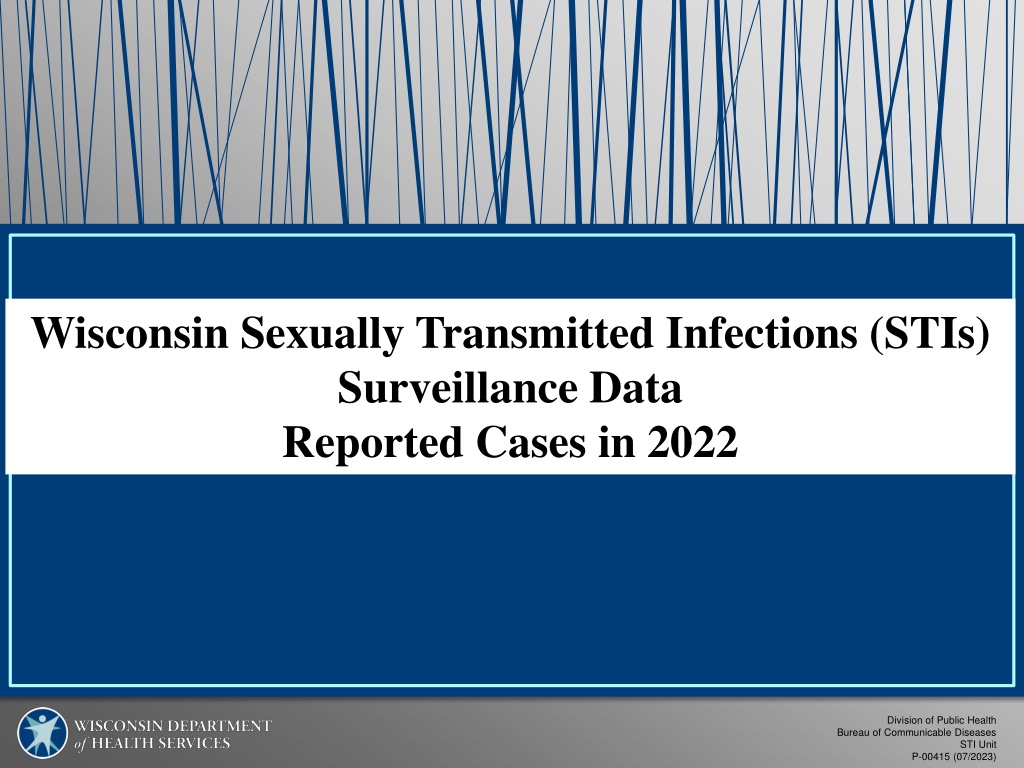
 undefined
undefined













